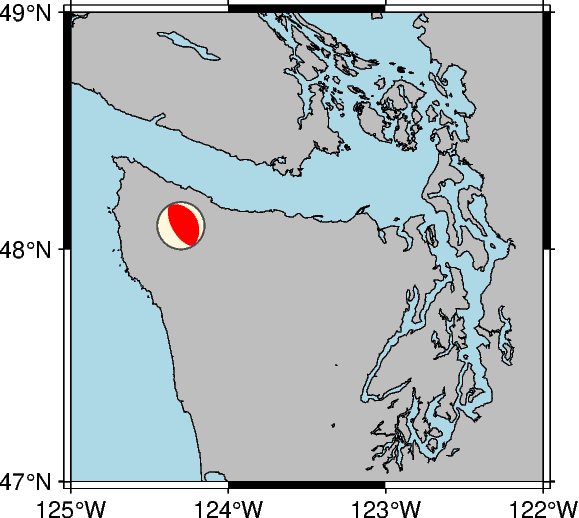Note
Go to the end to download the full example code.
Focal mechanisms
The pygmt.Figure.meca method can plot focal mechanisms or beachballs. We can
specify the focal mechanism nodal planes or moment tensor components as a dictionary
using the spec parameter (or they can be specified as a 1-D or 2-D array, or within
a file). The size of the beachballs can be set using the scale parameter. The
compressive and extensive quadrants can be filled either with a color or a pattern via
the compression_fill and extension_fill parameters, respectively. Use the
pen parameter to adjust the outline of the beachballs.

import pygmt
fig = pygmt.Figure()
# Generate a map near Washington State showing land, water, and shorelines
fig.coast(
region=[-125, -122, 47, 49],
projection="M6c",
land="grey",
water="lightblue",
shorelines=True,
frame="a",
)
# Store focal mechanism parameters in a dictionary based on the Aki & Richards
# convention
focal_mechanism = {"strike": 330, "dip": 30, "rake": 90, "magnitude": 3}
# Pass the focal mechanism data through the spec parameter. In addition provide
# scale, event location, and event depth
fig.meca(
spec=focal_mechanism,
scale="1c", # in centimeters
longitude=-124.3,
latitude=48.1,
depth=12.0,
# Fill compressive quadrants with color "red"
# [Default is "black"]
compression_fill="red",
# Fill extensive quadrants with color "cornsilk"
# [Default is "white"]
extension_fill="cornsilk",
# Draw a 0.5-point thick dark gray ("gray30") solid outline via
# the pen parameter [Default is "0.25p,black,solid"]
pen="0.5p,gray30,solid",
)
fig.show()
Total running time of the script: (0 minutes 0.158 seconds)